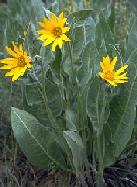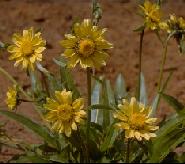

Northern Mule's Ears
Wyethia amplexiculis
Nutt
The plants are herbaceous with leafy stems and
large taproots.. The large showy heads are bright yellow and have disk
flowers.. The leaves are long, elliptical and pointed resembling the ears of a
mule and they grow on the stems as well as the base of the plant. The
plant is totally hairless and appears brightly polished, especially the green
bracts at the base of the heads. The stem leaves also clasp the stem. Flowers in late May through July.
It grows in sandy loa or gravel, sometimes with sagebrush, but often in more
moist meadow like areas. I is abundant in the high plains. Wyethia was named for
Nathaniel Wyeth, who
reported finding the specimen on 16 June 1833. It was among the specimens
sent to Nuttall.
Food Uses
The native North American Indians dug pits in the ground which they lined with
large stones. They then burnt a fire on top of the stones until the stones were
hot. The roots were placed on these hot stones, sealed in with fern leaves and
earth and then fermented for one or two days.
Value for Wildlife:
Mule deer prefer mules ears early in the growing season. Mature foliage is
coarse and harsh, and plants dry out by mid-summer, so it is little used after
early summer. Elk and deer eat the flower heads. Mules ears is generally
unpalatable. However, the leaves may be moderately palatable in the spring, and
flower heads are relished by deer and elk.
Mules ears often forms dense stands and may provide good cover for birds and small mammals. Blue grouse nests in Utah are commonly located in sagebrush-mules ears vegetation near trees or tall shrubs. (Source)
